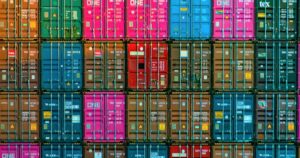
Due to the COVID-19 pandemic, companies around the world have faced a lot of difficulties in their supply chains. This situation forced many companies to reconsider their corporate strategy, because for several years, companies have worked under the system known as just-in-time (JIT), which focuses on keeping inventory to a minimumusing flexible contracts at short-term that could quickly adjust to changes in demand. However, in their quest to be as efficient as possible, companies moved production to low-wage locations, consolidated orders to maximize economies of scale, and tried to minimize their physical presence in countries and regions with tougher tax regulations.
This manufacturing and inventory management system worked very well, until the pandemic hit, causing factories to close or scale back operations. Once the countries have reduced the effects of the pandemic, the world´s economy began to change, which led many entrepreneurs to reevaluate their operation and manufacturing strategies and to consider the just-in-case (JIC) system.
In the following paragraphs we will talk about the characteristics of both systems, the proposal of a hybrid system between both and some elements that we suggest you consider in your supply chain from now on.
Just-in-Time (JIT)
The Just-in-Time model is designed to minimize inventory and increase efficiency, relying heavily on short-cycle manufacturing, consistent production, reliable suppliers, and predictable sales cycles. According to Oracle, its goal is to balance production´s volume with inventory levels and ensure that the company keeps only the product needed for short-term work available. It is an effective method of achieving high production levels with minimal inventory and supply costs.
However, it has the disadvantage that unexpected supply chain disruptions in any area can disrupt the entire process, just as we have seen during the global COVID-19 pandemic, where serious problems were created that affected thesupply and demand.
Just-in-Case (JIC)
The Just-in-Case model consists of producing, supplying or storing raw materials and finished goods in advance, having enough stocks at all times. Excess inventory is stored in the company's warehouses, in order to avoid running out of products, if there are disruptions in the supply chain. By carrying out this strategy, companies run the risk of tying up working capital in inventory, however, the risk of stockouts is lower. In addition, traders have the ability to quickly adapt to different factors such as weather, fuel prices, port congestion and other uncertainties in the supply chain.
This strategy is convenient when demand is difficult to predict or a raw material or component is subject to price surges or is in environments where suppliers are unreliable.
However, if demand slows and inventory stops, the system will be considered unusable or a waste of time and effort.
Employ a hybrid system
The primary goal of implementing a hybrid system is to address long-term and short-term production and sales needs by keeping inventory levels low enough to be profitable but high enough to withstand supplier delays and meet increased demand.
On the one hand, companies could use JIC inventory for essential articles, fast-moving items, ensuring that product is always available, but constantly consumed. It can also be useful for scarce items that are only available from unreliable suppliers, goods that are often out of stock, or have long lead times. On the other hand, companies could use JIT inventory for less popular items or those that are sold in small lots.
Final thoughts
According to a report written by Ernst & Young, companies must consider eight critical factors to adapt their regional supply chain strategies, especially in Southeast Asia :
- Customer Collaboration and Order Fulfillment: covering warehousing, logistics, and delivery planning to meet consumer expectations.
- Optimization of the value chain of regional trade and taxes: having an ideal positioning between countries to optimize the total cost of service associated with the acquisition, manufacture, import, transport, distribution and sale of goods.
- Presence, assets and investments: experience the appropriate level of geographic decentralization to serve high-growth markets at attractive costs.
- Supply chain visibility, intelligence, and traceability: own a well-integrated supply chain with minimal disruption and maximum collaboration.
- Product innovation: have the right balance between standardization and adaptation of the product to the specific requirements of the country.
- Resilience and sustainability of the supply chain: greater dependence on local supply at competitive prices.
- Workforce restructuring and upgrading: equipped with strategic thinking and problem-solving capabilities at different stages.
- Digital empowerment: employ Industry 4.0 and support manufacturing efficiency and flexibility, labor productivity, and workplace safety.
Finally, a sports footwear company in Mexico points out that, derived from the COVID-19 pandemic, they used the Just-in-Case model, that is, they ordered the merchandise in advance, in order not to suffer the lack ofproduct during peak seasons. Therefore, we suggest that companies review their supply chain planningto avoid delays or issues in the future.
Sources: